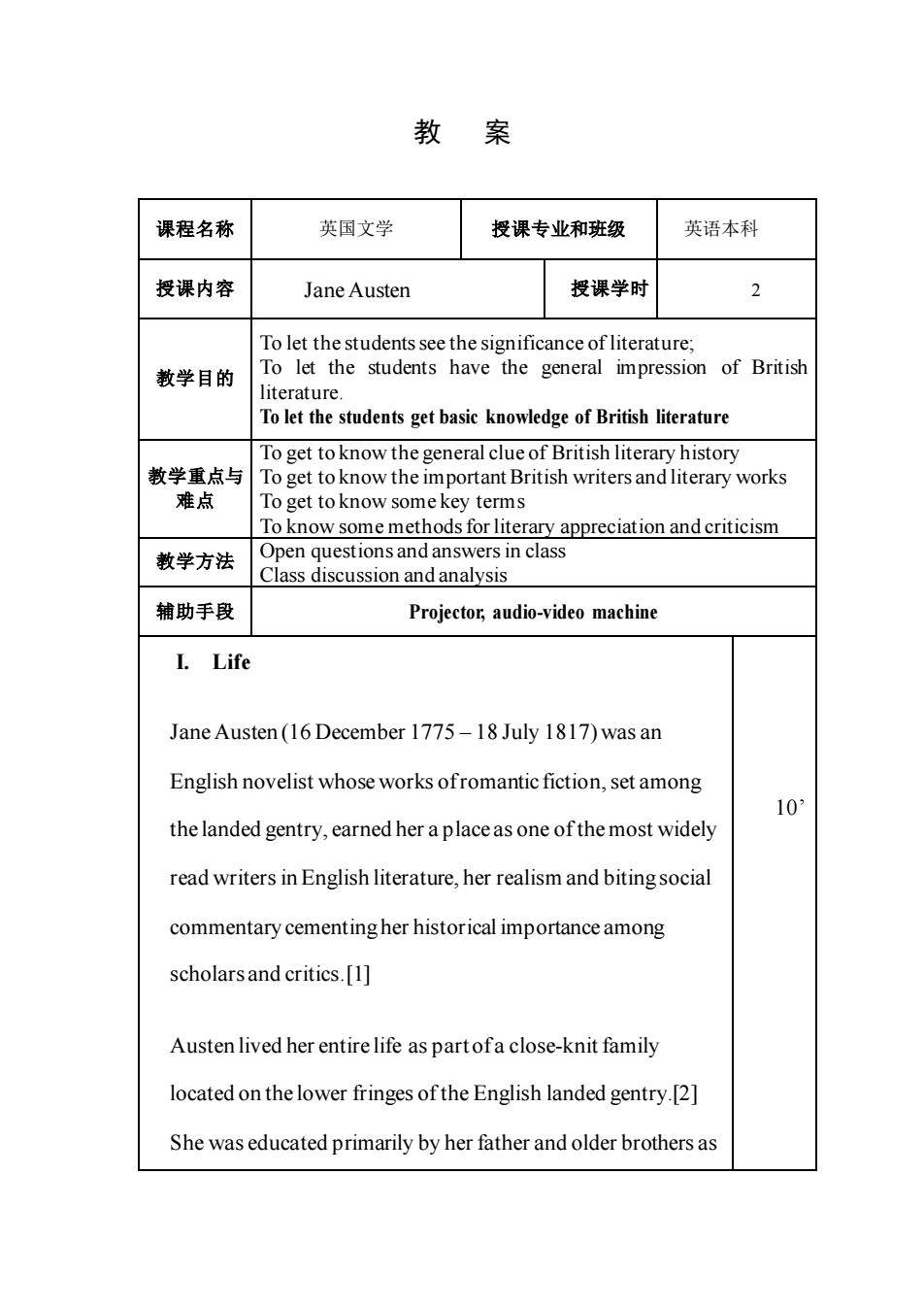
教案 课程名称 英国文学 授课专业和班级 英语本科 授课内容 Jane Austen 授课学时 To let the students see the significance of literature; 教学目的 To let the students have the general impression of British literature. To get to know the general clue of British literary history 教学重点与To get to know the important British writers and literary works 难点 To get to know some key terms To know some methods for literary appreciation and criticism 教学方法 Open questions and answers in class Class discussion and analysis 辅助手段 Projector,audio-video machine I.Life Jane Austen(16 December 1775-18 July 1817)was an English novelist whose works ofromantic fiction,set among 10 the landed gentry,earned her aplaceas one ofthe most widely read writers in English literature,her realism and biting social commentary cementing her historical importance among scholarsand critics.[1] Austen lived her entire life as partofa close-knit family located on thelower fringes ofthe English landed gentry.[2] She was educated primarily by her father and older brothers as
教 案 课程名称 英国文学 授课专业和班级 英语本科 授课内容 Jane Austen 授课学时 2 教学目的 To let the students see the significance of literature; To let the students have the general impression of British literature. To let the students get basic knowledge of British literature 教学重点与 难点 To get to know the general clue of British literary history To get to know the important British writers and literary works To get to know some key terms To know some methods for literary appreciation and criticism 教学方法 Open questions and answersin class Class discussion and analysis 辅助手段 Projector, audio-video machine I. Life Jane Austen (16 December 1775 – 18 July 1817) was an English novelist whose works of romantic fiction, set among the landed gentry, earned her a place as one of the most widely read writers in English literature, her realism and biting social commentary cementing her historical importance among scholars and critics.[1] Austen lived her entire life as part of a close-knit family located on the lower fringes of the English landed gentry.[2] She was educated primarily by her father and older brothers as 10’
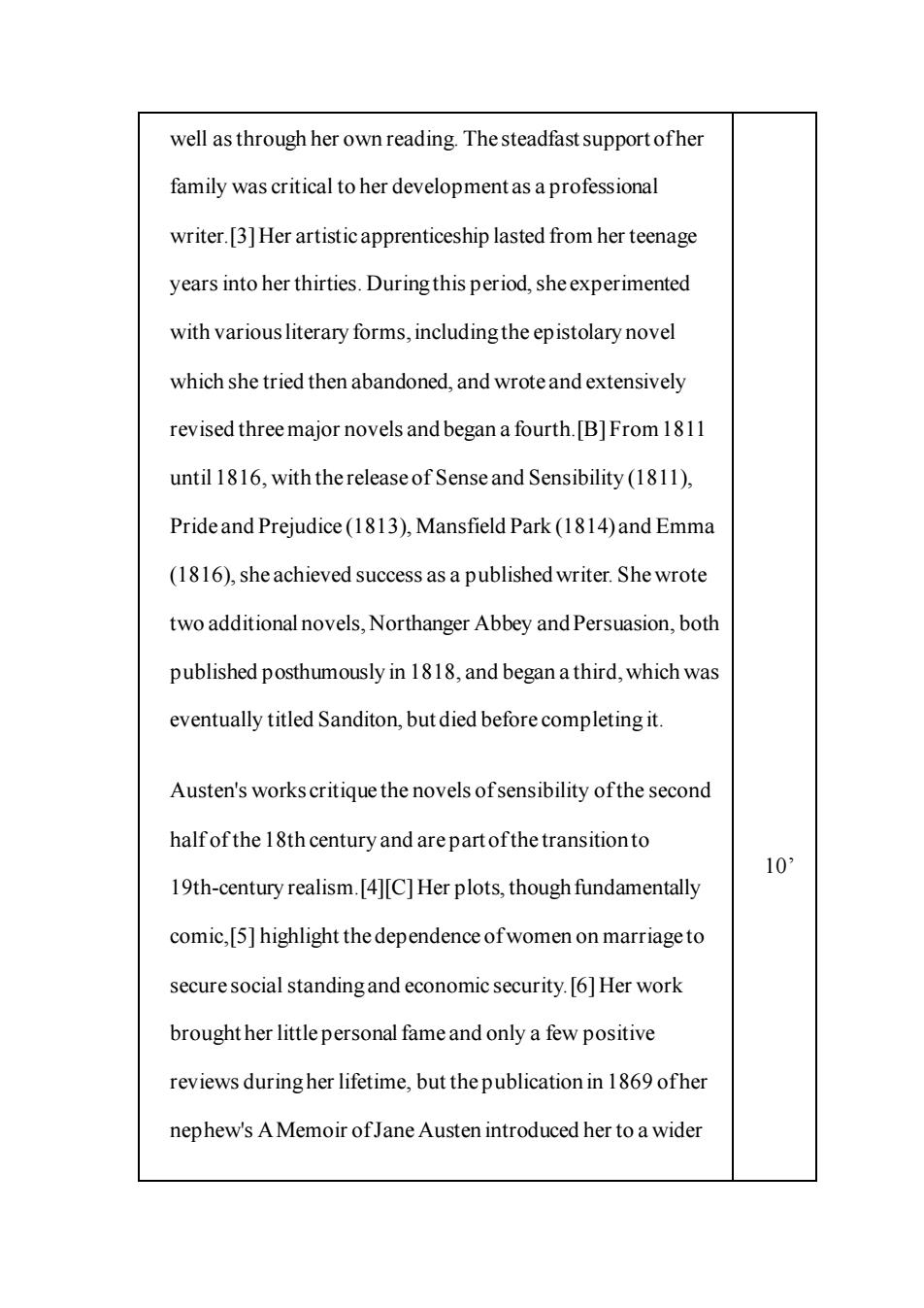
well as through her own reading.The steadfast support ofher family was critical to her development as a professional writer.3]Her artisticapprenticeship lasted from her teenage years into her thirties.During this period,sheexperimented with various literary forms,including the epistolary novel which she tried then abandoned,and wroteand extensively revised three major novels and began a fourth.[B]From 1811 until 1816,with the release of Sense and Sensibility(1811), Prideand Prejudice(1813),Mansfield Park(1814)and Emma (1816),sheachieved success as a published writer.She wrote two additional novels,Northanger Abbey and Persuasion.both published posthumously beganathird,which was eventually titled Sanditon,but died before completing it. Austen's works critique the novels ofsensibility ofthe second half of the 18th century and are part ofthe transitionto 10 19th-century realism.[4][C]Her plots,though fundamentally comic,[5]highlight the dependence ofwomen on marriage to secure social standing and economic security.[6]Her work brought her little personal fame and only a few positive reviews duringher lifetime,but thepublication in 1869ofher nephew's A Memoir of Jane Austen introduced her to a wider
well as through her own reading. The steadfast support of her family was critical to her development as a professional writer.[3]Her artistic apprenticeship lasted from her teenage years into her thirties. During this period, she experimented with various literary forms, including the epistolary novel which she tried then abandoned, and wrote and extensively revised three major novels and began a fourth.[B] From 1811 until 1816, with the release of Sense and Sensibility (1811), Pride and Prejudice (1813), Mansfield Park (1814) and Emma (1816), she achieved success as a published writer. She wrote two additional novels, Northanger Abbey and Persuasion, both published posthumously in 1818, and began a third, which was eventually titled Sanditon, but died before completing it. Austen's works critique the novels of sensibility of the second half of the 18th century and are part of the transition to 19th-century realism.[4][C]Her plots, though fundamentally comic,[5] highlight the dependence of women on marriage to secure social standing and economic security.[6]Her work brought her little personal fame and only a few positive reviews during her lifetime, but the publication in 1869 of her nephew's A Memoir of Jane Austen introduced her to a wider 10’
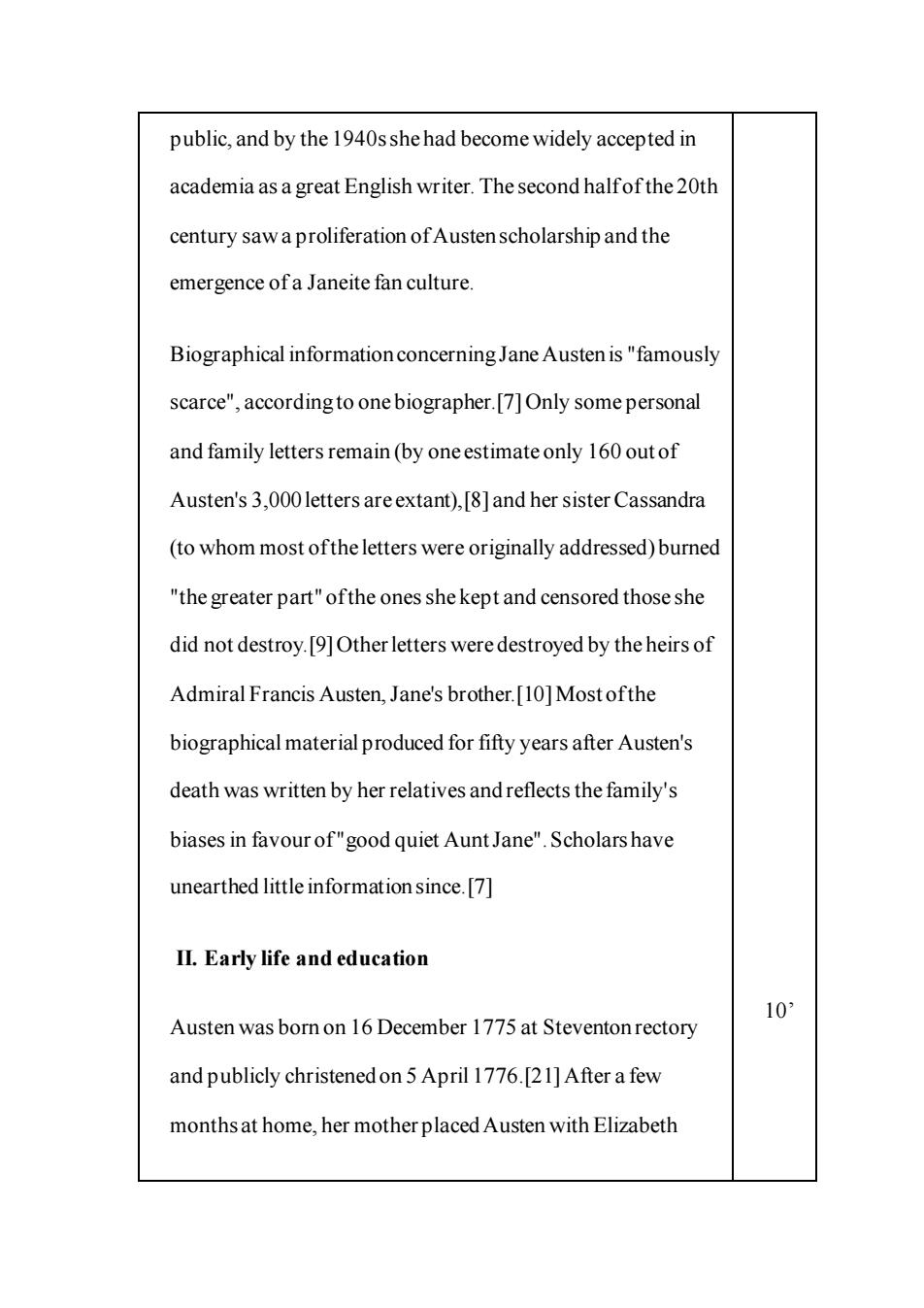
public,and by the 1940sshe had become widely accepted in academia as a great English writer.The second halfofthe 20th century saw a proliferation ofAustenscholarship and the emergence ofa Janeite fan culture Biographical informationconcerning Jane Austen is"famously scarce",according to one biographer.[7]Only some personal and family letters remain(by one estimate only 160 out of Austen's 3,000 letters are extant),[8]and her sister Cassandra (to whom most ofthe letters were originally addressed)burned "the greater part"ofthe ones she kept and censored those she did not destroy.[9]Other letters were destroyed by the heirs of Admiral Francis Austen,Jane's brother.[10]Most ofthe biographical material produced for fifty years after Austen's death was written by her relatives and reflects the family's biases in favour of"good quiet Aunt Jane".Scholars have unearthed little information since.[7] II.Early life and education Austen was born on 16 December 1775 at Steventon rectory 0. and publicly christened on 5 April 1776.[21]After a few months at home,her mother placed Austen with Elizabeth
public, and by the 1940s she had become widely accepted in academia as a great English writer. The second half of the 20th century saw a proliferation of Austen scholarship and the emergence of a Janeite fan culture. Biographical information concerning Jane Austen is "famously scarce", according to one biographer.[7]Only some personal and family letters remain (by one estimate only 160 out of Austen's 3,000 letters are extant),[8] and her sister Cassandra (to whom most of the letters were originally addressed) burned "the greater part" of the ones she kept and censored those she did not destroy.[9]Other letters were destroyed by the heirs of Admiral Francis Austen, Jane's brother.[10]Most of the biographical material produced for fifty years after Austen's death was written by her relatives and reflects the family's biases in favour of "good quiet Aunt Jane". Scholars have unearthed little information since.[7] II. Early life and education Austen was born on 16 December 1775 at Steventon rectory and publicly christened on 5 April 1776.[21] After a few months at home, her mother placed Austen with Elizabeth 10’

Littlewood,a womanliving nearby,who nursed andraised Austen for a year or eighteen months.[22]In 1783,according to family tradition,Jane and Cassandra were sent to Oxford to be educated by Mrs.Ann Cawley and they moved with her to Southampton later in the year.Both girls caught typhus and Jane nearly died.[23]Austen wassubsequently educated at home,until leaving for boarding school with her sister Cassandra early in 1785.The school curriculum probably included some French,spelling,needlework,dancingand music and,perhaps,drama.By December 1786,Jane and Cassandra had returned home because the Austens could not afford to send both oftheir daughters to school.[24] Austen acquired the remainder ofher education by reading books,guided by her father and her brothers Jamesand Henry.[25]George Austen apparently gave his daughters unfettered access to his large and varied library,was tolerant of Austen's sometimesrisque experiments in writing,and provided both sisters withexpensive paper and other materials for their writing and drawing.[26]Accordingto Park Honan,a biographer ofAusten,life in the Austen home was lived in"an open,amused,easy intellectual atmosphere"where the ideas of
Littlewood, a woman living nearby, who nursed and raised Austen for a year or eighteen months.[22]In 1783, according to family tradition, Jane and Cassandra were sent to Oxford to be educated by Mrs. Ann Cawley and they moved with her to Southampton later in the year. Both girls caught typhus and Jane nearly died.[23]Austen was subsequently educated at home, until leaving for boarding school with her sister Cassandra early in 1785. The school curriculum probably included some French, spelling, needlework, dancing and music and, perhaps, drama. By December 1786, Jane and Cassandra had returned home because the Austens could not afford to send both of their daughters to school.[24] Austen acquired the remainder of her education by reading books, guided by her father and her brothers James and Henry.[25]George Austen apparently gave his daughters unfettered access to his large and varied library, was tolerant of Austen's sometimes risqué experiments in writing, and provided both sisters with expensive paper and other materials for their writing and drawing.[26] According to Park Honan, a biographer of Austen, life in the Austen home was lived in "an open, amused, easy intellectual atmosphere" where the ideas of
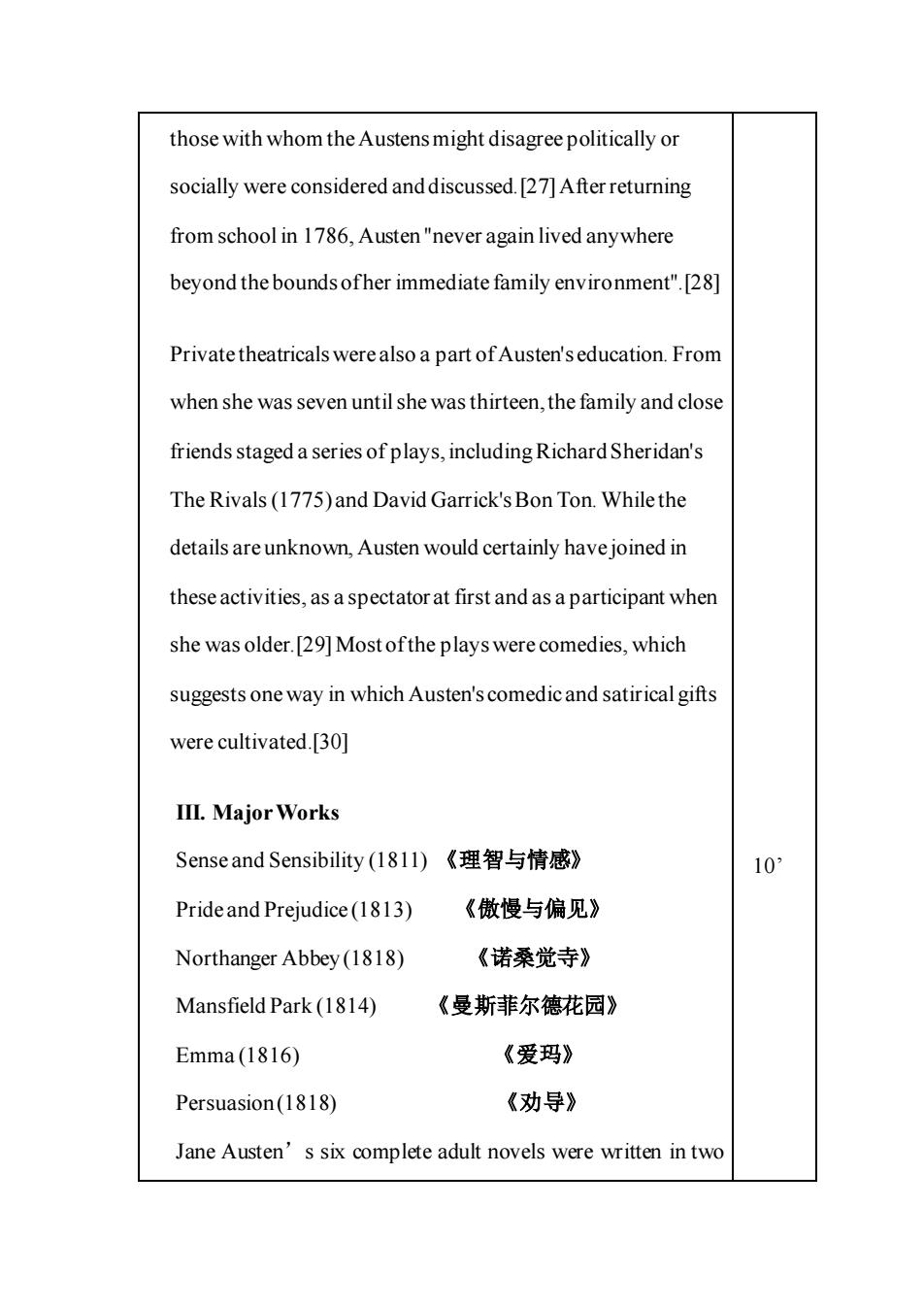
those with whom the Austens might disagree politically or socially were considered and discussed.[27]After returning from school in 1786,Austen"never again lived anywhere beyond the bounds ofher immediate family environment".[28] Private theatricals were also a part ofAusten'seducation.From when she was seven until she was thirteen,the family and close friends staged a series of plays,including Richard Sheridan's The Rivals(1775)and David Garrick's Bon Ton.While the details are unknown,Austen would certainly have joined in these activities,as a spectator at first and as a participant when she was older.[29]Most ofthe plays were comedies,which suggests one way in which Austen's comedicand satirical gifts were cultivated.[30] III.Major Works Senseand Sensibility(I8ll)《理智与情感》 10 Prideand Prejudice(1813) 《傲慢与偏见》 Northanger Abbey(1818) 《诺桑觉寺》 Mansfield Park(1814) 《曼斯菲尔德花园》 Emma(1816) 《爱玛》 Persuasion(1818) 《劝导》 Jane Austen's six complete adult novels were written in two
those with whom the Austens might disagree politically or socially were considered and discussed.[27]After returning from school in 1786, Austen "never again lived anywhere beyond the bounds of her immediate family environment".[28] Private theatricals were also a part of Austen's education. From when she was seven until she was thirteen, the family and close friends staged a series of plays, including Richard Sheridan's The Rivals (1775) and David Garrick'sBon Ton. While the details are unknown, Austen would certainly have joined in these activities, as a spectator at first and as a participant when she was older.[29]Most of the plays were comedies, which suggests one way in which Austen's comedic and satirical gifts were cultivated.[30] III. Major Works Sense and Sensibility (1811) 《理智与情感》 Pride and Prejudice (1813) 《傲慢与偏见》 Northanger Abbey (1818) 《诺桑觉寺》 Mansfield Park (1814) 《曼斯菲尔德花园》 Emma (1816) 《爱玛》 Persuasion (1818) 《劝导》 Jane Austen’s six complete adult novels were written in two 10’
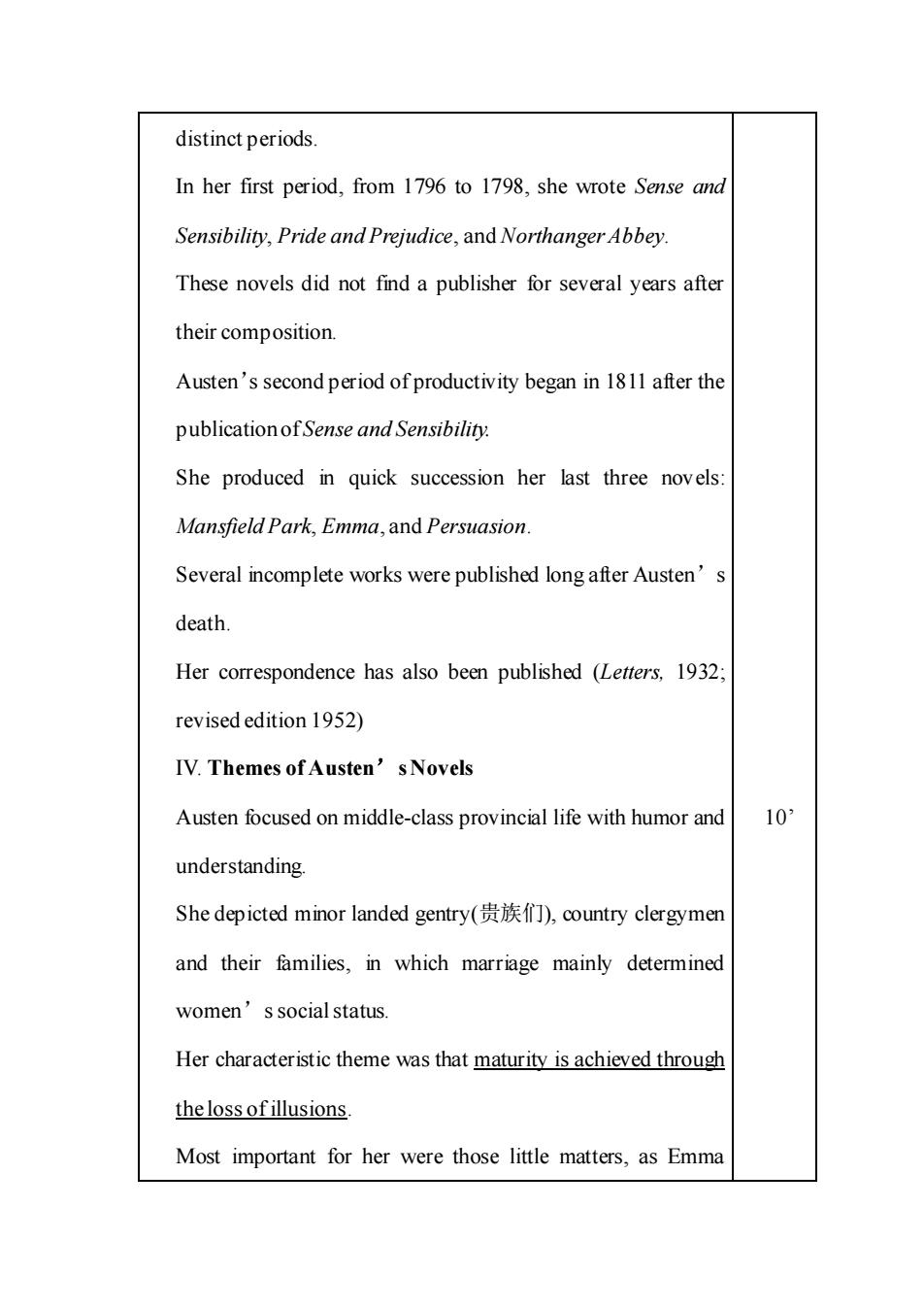
distinct periods In her first period,from 1796 to 1798,she wrote Sense and Sensibility,Pride and Prejudice,and Northanger Abbey. These novels did not find a publisher for several years after their composition. Austen's second period of productivity began in 1811 after the publicationof Sense and Sensibility. She produced in quick succession her last three novels: Mansfield Park,Emma,and Persuasion. Several incomplete works were published long after Austen's death. Her correspondence has also been published (Letters,1932 revised edition 1952) IV.Themes ofAusten's Novels Austen focused on middle-class provincial life with humor and 10 understanding. She depicted minor landed gentry(贵族们),country clergymen and their families,in which marriage mainly determined women's social status. Her characteristic theme was that maturity is achieved through the loss of illusions. Most important for her were those little matters,as Emma
distinct periods. In her first period, from 1796 to 1798, she wrote Sense and Sensibility, Pride and Prejudice, and Northanger Abbey. These novels did not find a publisher for several years after their composition. Austen’s second period of productivity began in 1811 after the publication of Sense and Sensibility. She produced in quick succession her last three novels: Mansfield Park, Emma, and Persuasion. Several incomplete works were published long after Austen’s death. Her correspondence has also been published (Letters, 1932; revised edition 1952) IV. Themes of Austen’s Novels Austen focused on middle-class provincial life with humor and understanding. She depicted minor landed gentry(贵族们), country clergymen and their families, in which marriage mainly determined women’s social status. Her characteristic theme was that maturity is achieved through the loss of illusions. Most important for her were those little matters, as Emma 10’
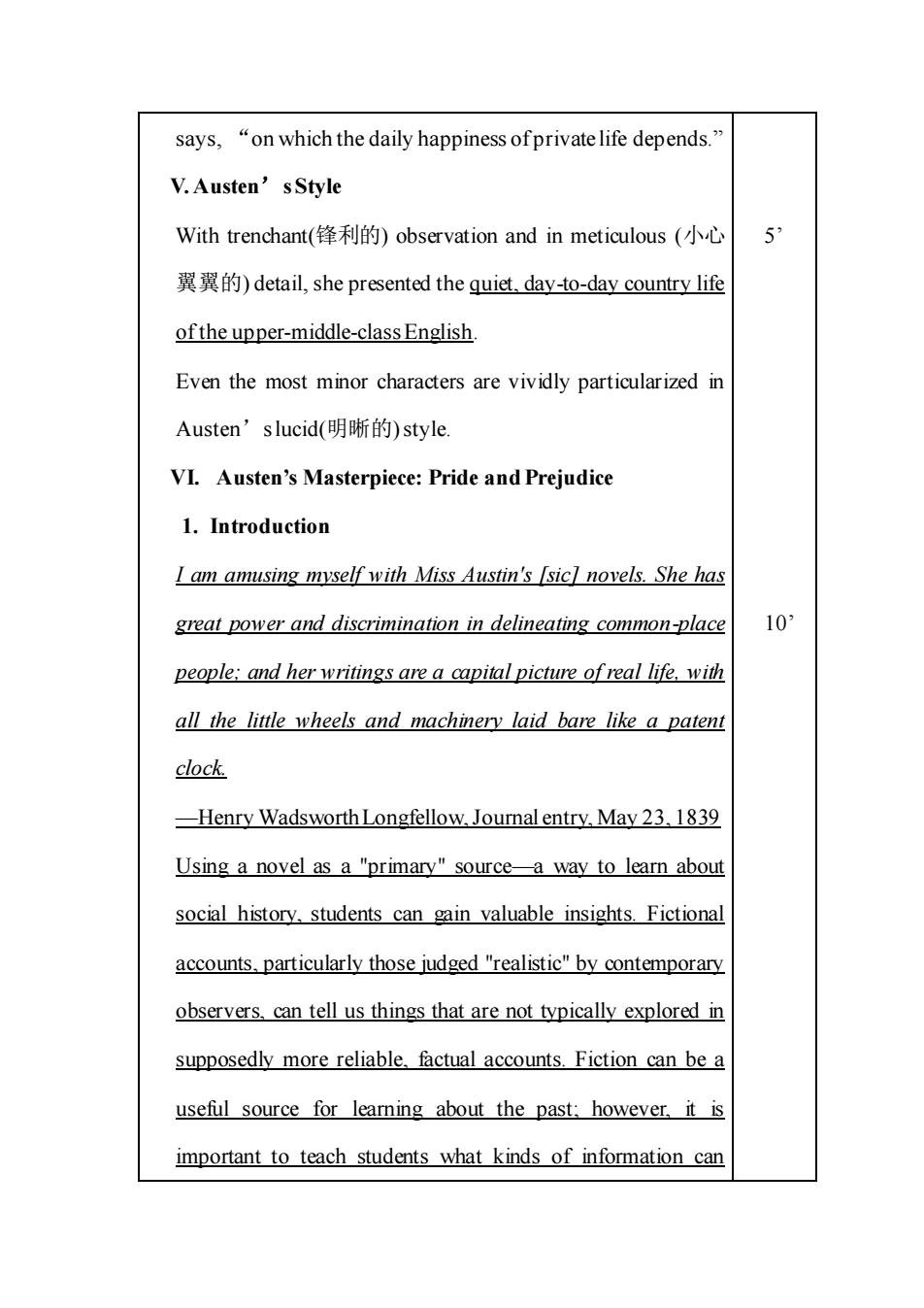
says,"on which the daily happiness ofprivate life depends.' V.Austen'sStyle With trenchant(锋利的)observation and in meticulous(小心 5 翼翼的)detail,she presented the quiet.day-to-day country life of the upper-middle-class English. Even the most minor characters are vividly particularized in Austen’slucid(明晰的)style. VI Austen's Masterpiece:Pride and Prejudice 1.Introduction I am amusing myself with Miss Austin's [sic]novels.She has great power and discrimination in delineating common-place 10 people:and her writings are a capital picture of real life with all the little wheels and machinery laid bare like a patent clock. -Henry Wadsworth Longfellow,Journal entry May 23.1839 Using a novel as a "primary"sourcea way to learn about social history,students can gain valuable insights Fictional accounts,particularly those judged "realistic"by contemporary observers,can tell us things that are not typically explored in supposedly more reliable factual accounts.Fiction can be a useful source for learning about the past:however,it is important to teach students what kinds of information can
says, “on which the daily happiness of private life depends.” V. Austen’s Style With trenchant(锋利的) observation and in meticulous (小心 翼翼的) detail, she presented the quiet, day-to-day country life of the upper-middle-class English. Even the most minor characters are vividly particularized in Austen’s lucid(明晰的) style. VI. Austen’s Masterpiece: Pride and Prejudice 1. Introduction I am amusing myself with Miss Austin's [sic] novels. She has great power and discrimination in delineating common-place people; and her writings are a capital picture of real life, with all the little wheels and machinery laid bare like a patent clock. —Henry Wadsworth Longfellow, Journal entry, May 23, 1839 Using a novel as a "primary" source—a way to learn about social history, students can gain valuable insights. Fictional accounts, particularly those judged "realistic" by contemporary observers, can tell us things that are not typically explored in supposedly more reliable, factual accounts. Fiction can be a useful source for learning about the past; however, it is important to teach students what kinds of information can 5’ 10’
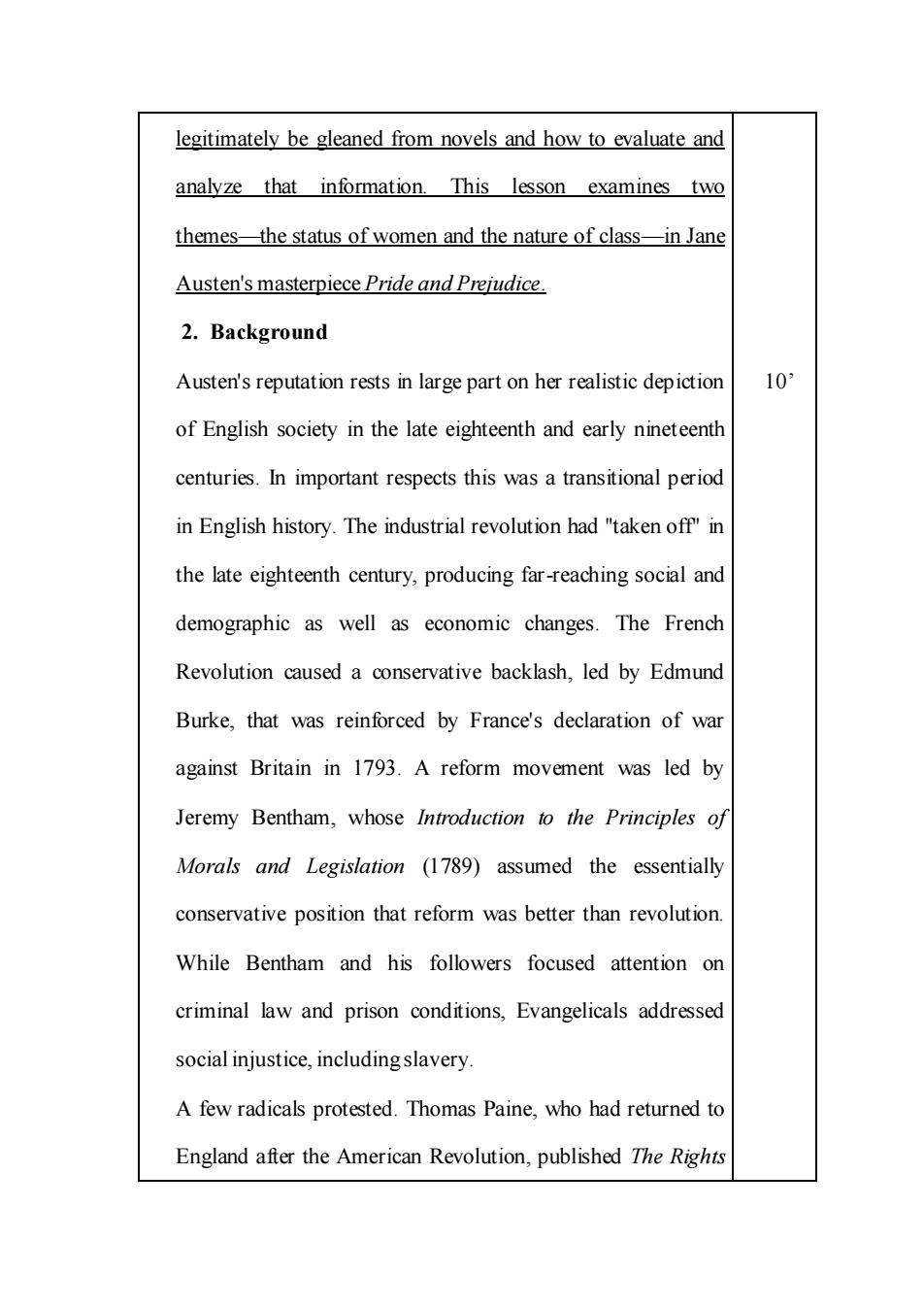
legitimately be gleaned from novels and how to evaluate and analyze that information.This lesson examines two themesthe status of women and the nature of class-in Jane Austen's masterpiece Pride and Prejudice. 2.Background Austen's reputation rests in large part on her realistic depiction 10, of English society in the late eighteenth and early nineteenth centuries.In important respects this was a transitional period in English history.The industrial revolution had "taken off"in the late eighteenth century,producing far-reaching social and demographic as well as economic changes.The French Revolution caused a conservative backlash,led by Edmund Burke,that was reinforced by France's declaration of war against Britain in 1793.A reform movement was led by Jeremy Bentham,whose Introduction to the Principles of Morals and Legislation (1789)assumed the essentially conservative position that reform was better than revolution While Bentham and his followers focused attention on criminal law and prison conditions,Evangelicals addressed social injustice,includingslavery A few radicals protested.Thomas Paine,who had returned to England after the American Revolution,published The Rights
legitimately be gleaned from novels and how to evaluate and analyze that information. This lesson examines two themes—the status of women and the nature of class—in Jane Austen's masterpiece Pride and Prejudice. 2. Background Austen's reputation rests in large part on her realistic depiction of English society in the late eighteenth and early nineteenth centuries. In important respects this was a transitional period in English history. The industrial revolution had "taken off" in the late eighteenth century, producing far-reaching social and demographic as well as economic changes. The French Revolution caused a conservative backlash, led by Edmund Burke, that was reinforced by France's declaration of war against Britain in 1793. A reform movement was led by Jeremy Bentham, whose Introduction to the Principles of Morals and Legislation (1789) assumed the essentially conservative position that reform was better than revolution. While Bentham and his followers focused attention on criminal law and prison conditions, Evangelicals addressed social injustice, including slavery. A few radicals protested. Thomas Paine, who had returned to England after the American Revolution, published The Rights 10’
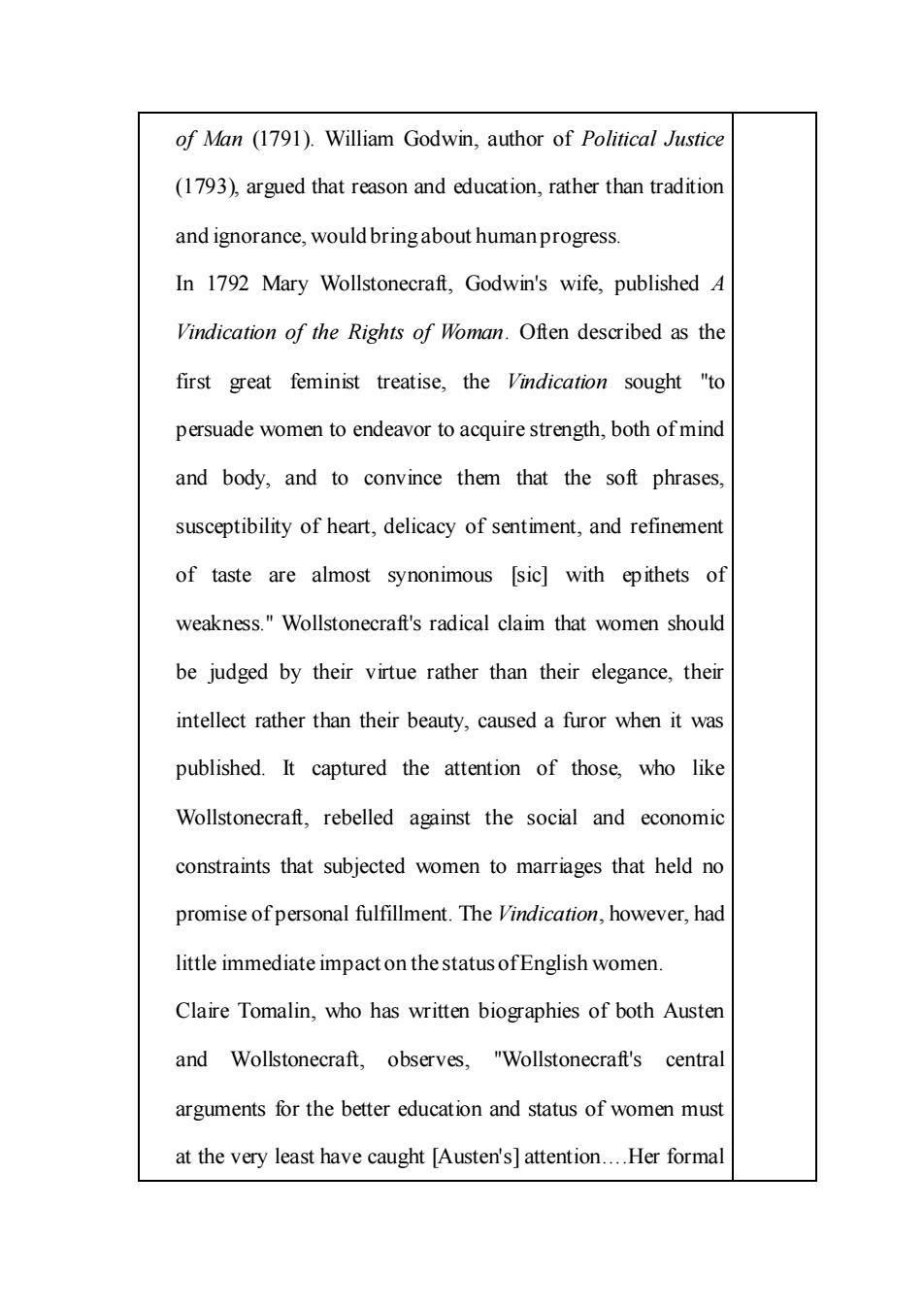
of Man (1791).William Godwin,author of Political Justice (1793),argued that reason and education,rather than tradition and ignorance,would bring about human progress. In 1792 Mary Wollstonecraft,Godwin's wife,published A Vindication of the Rights of Woman.Often described as the first great feminist treatise,the Vindication sought "to persuade women to endeavor to acquire strength,both of mind and body,and to convince them that the soft phrases. susceptibility of heart,delicacy of sentiment,and refinement of taste are almost synonimous [sic]with epithets of weakness."Wollstonecraft's radical claim that women should be judged by their virtue rather than their elegance,their intellect rather than their beauty,caused a furor when it was published.It captured the attention of those,who like Wollstonecraf,rebelled against the social and economic constraints that subjected women to marriages that held no promise of personal fulfillment.The Vindication,however,had little immediate impact on the status ofEnglish women. Claire Tomalin,who has written biographies of both Austen and Wollstonecraft,observes,"Wollstonecraft's central arguments for the better education and status of women must at the very least have caught [Austen's]attention.Her formal
of Man (1791). William Godwin, author of Political Justice (1793), argued that reason and education, rather than tradition and ignorance, would bring about human progress. In 1792 Mary Wollstonecraft, Godwin's wife, published A Vindication of the Rights of Woman. Often described as the first great feminist treatise, the Vindication sought "to persuade women to endeavor to acquire strength, both of mind and body, and to convince them that the soft phrases, susceptibility of heart, delicacy of sentiment, and refinement of taste are almost synonimous [sic] with epithets of weakness." Wollstonecraft's radical claim that women should be judged by their virtue rather than their elegance, their intellect rather than their beauty, caused a furor when it was published. It captured the attention of those, who like Wollstonecraft, rebelled against the social and economic constraints that subjected women to marriages that held no promise of personal fulfillment. The Vindication, however, had little immediate impact on the status of English women. Claire Tomalin, who has written biographies of both Austen and Wollstonecraft, observes, "Wollstonecraft's central arguments for the better education and status of women must at the very least have caught [Austen's] attention.Her formal
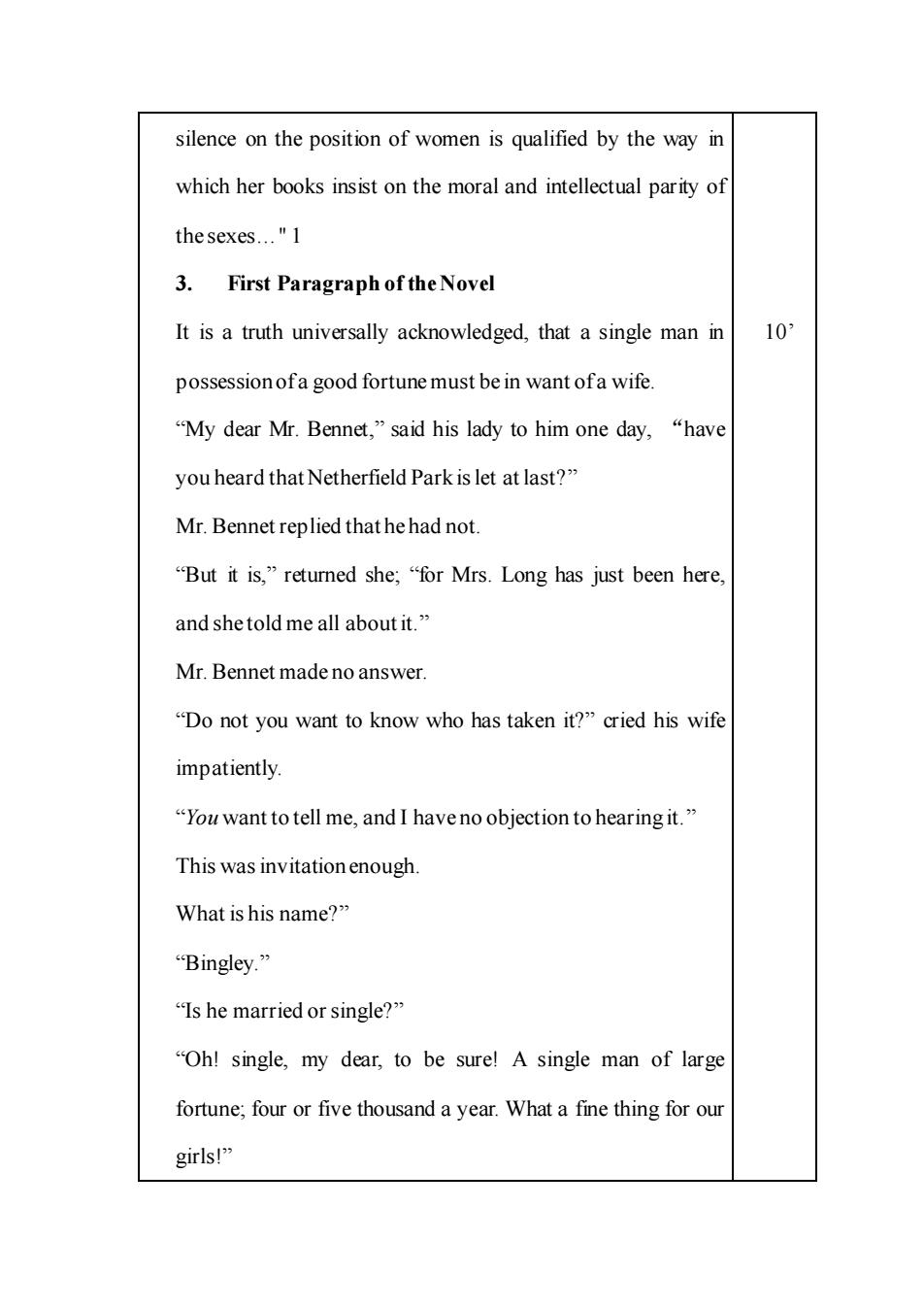
silence on the position of women is qualified by the way in which her books insist on the moral and intellectual parity of thesexes."1 3.First Paragraph of the Novel It is a truth universally acknowledged,that a single man in 10 possessionofa good fortune must be in want ofa wife. "My dear Mr.Bennet,"said his lady to him one day,"have you heard that Netherfield Park is let at last?" Mr.Bennet replied thathehad not. "But it is,"returned she;"for Mrs.Long has just been here, and shetold me all about it." Mr.Bennet made no answer. "Do not you want to know who has taken it?"cried his wife impatiently. "You want to tell me,and I haveno objection to hearing it." This was invitation enough What is his name?" Bingley.” "Is he married or single?" "Oh!single,my dear,to be sure!A single man of large fortune;four or five thousand a year.What a fine thing for our girls!
silence on the position of women is qualified by the way in which her books insist on the moral and intellectual parity of the sexes." 1 3. First Paragraph of the Novel It is a truth universally acknowledged, that a single man in possession of a good fortune must be in want of a wife. “My dear Mr. Bennet,” said his lady to him one day, “have you heard that Netherfield Park is let at last?” Mr. Bennet replied that he had not. “But it is,” returned she; “for Mrs. Long has just been here, and she told me all about it.” Mr. Bennet made no answer. “Do not you want to know who has taken it?” cried his wife impatiently. “You want to tell me, and I have no objection to hearing it.” This was invitation enough. What is his name?” “Bingley.” “Is he married or single?” “Oh! single, my dear, to be sure! A single man of large fortune; four or five thousand a year. What a fine thing for our girls!” 10’